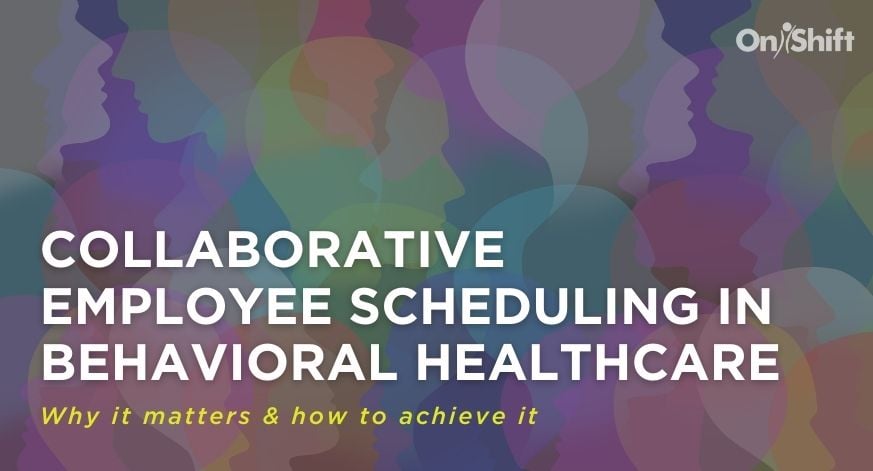
If you want to remain competitive, it’s essential that you have the right scheduling practices in place. And that means creating a process that goes beyond just creating and posting a schedule -- one that gives employees a say in when they work and allows you to collaborate with them on scheduling needs.
Understanding Staffing Gaps & Utilization
When creating best-fit schedules, i.e. schedules that work for your organization and your employees, start by having a clear understanding of where your current staffing gaps exist. Look back at some of your past schedules. Are the same shifts going unfilled? Are there certain days or times that are always particularly hard to staff? Do you notice a pattern of call-offs with any of your employees?
Next, look at how well you’re currently utilizing your staff. If your organization defines a full-time employee as 40 hours, make sure all of your full-time employees are meeting this requirement. Do the same for part-time staff, as well as any PRN employees. It’s not uncommon to uncover staff members that aren’t being fully utilized. Or, on the reverse, employees that are working more hours than perhaps they should, creating excess overtime or making them eligible for certain benefits.
Employee scheduling software such as OnShift Schedule makes it easy for those managing the schedule to quickly identify gaps and consistently monitor employee utilization. This allows providers to get the most out of the staff they have.
Once you understand the gaps you have and the potential availability of your employees, it’s time to put them together. Start by working with any underutilized employees to get those additional hours on the schedule. Once you’ve fully maximized the use of your staff, see what gaps still exist—this is where you should target your hiring efforts.
Scheduling Transparency Starts Before Day 1
As you’re bringing on new hires, make sure they understand any expectations around the days and times they should be available to work. The best way to start is by putting shift details and requirements right in your job postings.
Once a candidate is brought in, be sure to ask which days and times they would prefer to work. Ideally, they should coincide with the details outlined in the job posting. If not, be clear with the candidate as to what’s expected and make sure that those shift days and times are something they can commit to. This will go a long way in helping to decrease last-minute call-offs or no-shows in the future.
Visibility Holds The Key To Engaging Employees In The Scheduling Process
The best way to create a truly collaborative scheduling experience is to provide staff with mobile access to view and manage their schedule anytime, anywhere. Something as simple as giving staff real-time access to their schedule can go a long way in holding employees accountable for following the schedule.
The OnShift All-In-One Mobile App for employees makes it easy for staff to see when they’re scheduled next, as well as view and request open shifts. Shift request approvals can even be automated for those not at risk of incurring overtime as a result. By automating this process, behavioral health organizations can spend less time managing the schedule and employees get the instant gratification of knowing they’ve been assigned to a shift of their choice.
Make sure you’re giving employees ample time to review new schedules by posting them two to four weeks in advance. This allows staff to manage any potential conflicts they may have and pick up any additional shifts that are still available.
Communication Is Essential
Scheduling changes happen—be sure to communicate them in real time with your employees.
If a change in demand or a scheduling error results in the need to cancel a shift, make sure employees are notified right away. Failing to do so could negatively impact overall staff satisfaction and engagement, as no one wants to show up to work only to find out their shift was canceled.
To curb scheduling headaches for behavioral healthcare providers, make sure you have a process in place to notify staff of last-minute shift needs due to call-offs or no-shows. Manually calling down a list of names, hoping someone not only answers the phone but is available to take a shift, is inefficient and ineffective. It can also lead to unintended favoritism as those managing the schedule turn to those select few that they believe will say “yes” to an opening.
OnShift’s employee scheduling software makes it easy to communicate with employees—whether it’s an unexpected open shift or a change to an individual schedule. Staff can receive notifications right on their mobile device via text message or push notification if they are using the OnShift All-In-One Mobile App for Employees.
Creating a collaborative scheduling experience shouldn’t be difficult. And the pay-off for both your organization and your employees can be big. Make sure you have the right technology in place, as manual scheduling methods such as pen and paper or spreadsheets make it extremely difficult, if not impossible, to provide the visibility both you and your staff need.